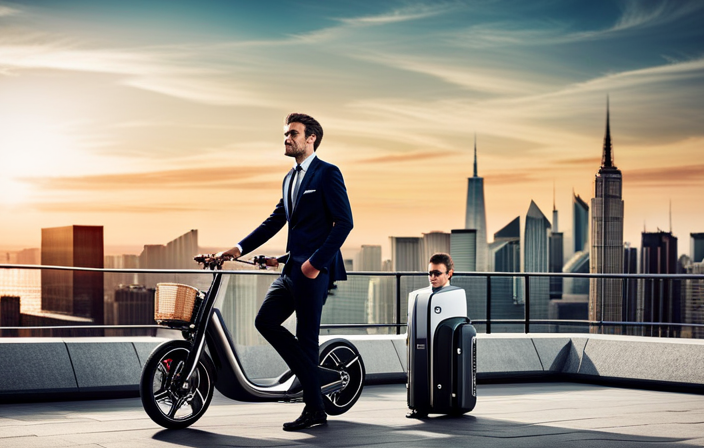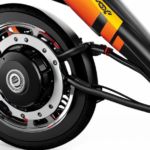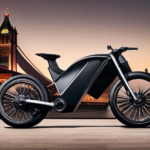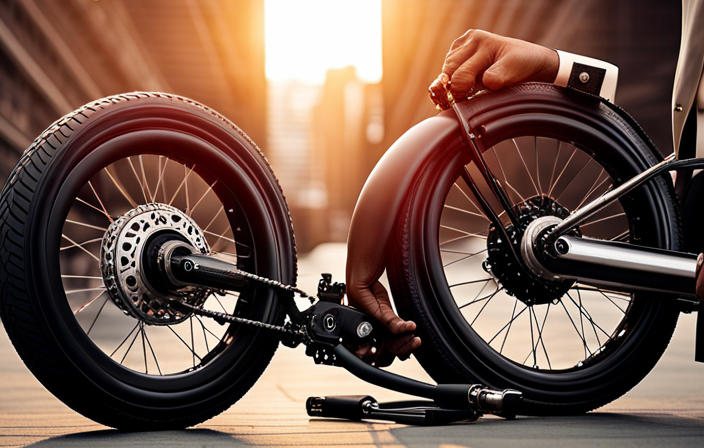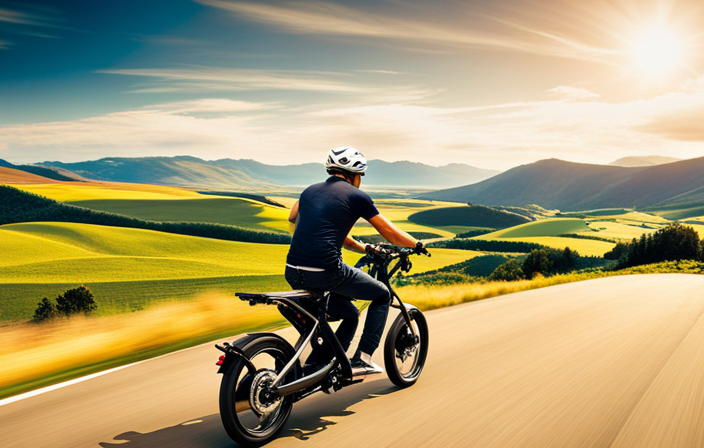As I embark on this journey to unravel the inner workings of electric bikes, I am reminded of the famous quote by Ralph Waldo Emerson: ‘Do not go where the path may lead, go instead where there is no path and leave a trail.’
In this article, we will delve into the intricate technology behind electric bikes, exploring how they harness electrical energy to propel us forward.
Join me as we navigate through the complexities of battery-powered motors, controllers, and the ever-evolving landscape of electric bike innovation.
Key Takeaways
- Electric bikes combine pedal power and motor assistance.
- Sensors detect rider’s effort and signal the motor.
- Battery-powered motor converts electrical energy into mechanical energy.
- Controller regulates power output for optimal performance.
The Basics of Electric Bike Technology
Want to learn about the fascinating world of electric bike technology and how it actually works? Well, let’s start with the basics.
Electric bikes, also known as e-bikes, use a combination of pedal power and motor assistance to propel riders. The key to their operation lies in the pedal efficiency and motor power delivery.
When you pedal, the bike’s sensors detect your effort and send a signal to the motor, which then kicks in to provide additional power. This motor power delivery varies depending on the level of assistance chosen by the rider.
Understanding the battery-powered motor is crucial to comprehending the inner workings of electric bikes. It is responsible for converting stored electrical energy into mechanical energy, allowing you to effortlessly conquer hills and cover longer distances.
Understanding the Battery-Powered Motor
One fascinating statistic about the battery-powered motor is that it can provide up to 60 kilometers of range on a single charge. This impressive range is made possible by the advanced lithium-ion battery technology used in electric bikes.
However, it is important to note that battery maintenance is crucial for optimal performance and longevity. Regularly charging the battery, avoiding extreme temperatures, and keeping it clean are some of the ways to ensure its efficiency.
Additionally, troubleshooting common issues such as a decrease in range or sudden power loss can often be resolved by checking the battery connections, inspecting for any damage, or recalibrating the system.
Understanding and properly maintaining the battery-powered motor is essential for a reliable and enjoyable electric bike experience.
Moving forward, it is important to delve into how the motor converts electrical energy into mechanical energy.
How the Motor Converts Electrical Energy into Mechanical Energy
The motor takes electrical energy and converts it into mechanical energy, powering the bike forward. The efficiency of the motor is a crucial factor in determining how well it converts electrical energy into mechanical energy. Motor efficiency is defined as the ratio of mechanical power output to electrical power input. Higher efficiency means that less electrical energy is wasted as heat and more is used to propel the bike.
To achieve high motor efficiency, manufacturers use advanced technologies such as brushless motors and permanent magnets. These technologies reduce friction and maximize power output. The power output of the motor is another important aspect. It determines how fast the bike can go and how well it can handle inclines. The power output is usually measured in watts and can vary depending on the specific motor used.
In the next section, we will explore the role of the controller in regulating power output, ensuring optimal performance.
The Role of the Controller in Regulating Power Output
When it comes to controlling the power output, you’ll find that the controller plays a crucial role in ensuring optimal performance. The controller technology used in electric bikes is responsible for regulating the power that is sent from the battery to the motor. It acts as a bridge between the rider’s input and the desired power output.
Here are four key functions of the controller:
-
Power regulation: The controller adjusts the amount of power that is delivered to the motor based on the rider’s input and the selected power assist level.
-
Speed control: It allows the rider to set a maximum speed limit for the electric bike, ensuring safety and compliance with local regulations.
-
Torque control: The controller modulates the motor’s torque output, providing smooth acceleration and control on different terrains.
-
Battery protection: It monitors the battery’s voltage and prevents overcharging or discharging, prolonging its lifespan.
With advanced controller technology, electric bikes can deliver efficient power regulation and enhance the overall riding experience.
Now, let’s explore different types of electric bike batteries.
Exploring Different Types of Electric Bike Batteries
Discovering the wide range of battery options available for your e-bike will ignite your excitement for the possibilities of extended rides and endless adventures. When it comes to electric bike batteries, there are two main types to consider: lithium-ion and lead-acid. Let’s compare their battery capacity. In the table below, you can see that lithium-ion batteries generally have a higher capacity than lead-acid batteries. This means they can store more energy and provide a longer range for your rides.
| Battery Type | Capacity (Ah) |
|---|---|
| Lithium-ion | 10 |
| Lead-acid | 5 |
Another important aspect to consider is whether the battery is removable or integrated. Removable batteries offer the advantage of being easy to replace and upgrade, while integrated batteries provide a sleeker design and better protection against theft. Now that we have explored the different types of electric bike batteries, let’s delve into how the battery is charged and stored, ensuring optimal performance and longevity.
How the Battery is Charged and Stored
After exploring the different types of electric bike batteries, it is important to understand how these batteries are charged and stored.
There are various charging methods available for electric bike batteries, including plug-in charging, removable battery charging, and regenerative braking. Plug-in charging is the most common method, where the battery is connected to a charger and plugged into an electrical outlet. Removable battery charging allows users to remove the battery from the bike and charge it separately. Regenerative braking, on the other hand, charges the battery while riding by converting kinetic energy into electrical energy.
It is important to note that the charging method used can affect the battery lifespan. Proper charging and storage techniques, such as avoiding overcharging and extreme temperatures, can help extend the battery’s longevity.
Transitioning into the subsequent section about the importance of proper maintenance for longevity, it is crucial to understand the impact of maintenance on the overall performance and lifespan of an electric bike.
The Importance of Proper Maintenance for Longevity
To ensure your electric bike keeps running smoothly and lasts for years to come, you need to give it the same care and attention as a well-tuned instrument needs regular maintenance. Here are four proper maintenance tips that will help you prolong the life of your electric bike:
-
Regularly clean the bike: Cleaning your electric bike not only keeps it looking good, but it also helps prevent dirt and debris from damaging the components.
-
Check the tire pressure: Maintaining the correct tire pressure is crucial for a smooth and efficient ride. Low tire pressure can cause increased rolling resistance and reduce battery life.
-
Lubricate the moving parts: Applying lubrication to the chain, gears, and other moving parts will reduce friction and keep them working smoothly.
-
Schedule regular check-ups: Just like any other vehicle, electric bikes also require periodic maintenance by a professional. Regular check-ups can identify and fix any potential issues before they become major problems.
Proper maintenance ensures that your electric bike operates at its best and provides you with a reliable and enjoyable riding experience.
Next, we will explore the function of the pedal-assist system.
The Function of the Pedal-Assist System
The pedal-assist system enhances the riding experience by providing an additional boost of power when the rider pedals. This system is designed to make cycling easier and more efficient, especially when tackling challenging terrains or going uphill. The pedal-assist system works by using sensors to detect the rider’s pedaling cadence and speed. These sensors then send signals to the motor, which provides the necessary power to assist the rider. The table below illustrates the benefits and efficiency of the pedal-assist system.
| Benefits | Efficiency |
|---|---|
| Increases speed | Maximizes battery life |
| Reduces effort | Extends riding range |
| Helps with uphill climbs | Enhances overall performance |
By utilizing the pedal-assist system, riders can enjoy the benefits of increased speed, reduced effort, and improved performance. This system optimizes the efficiency of the electric bike, maximizing battery life and extending the riding range. In the subsequent section, we will explore the role of sensors in monitoring speed and pedaling cadence, further enhancing the riding experience.
The Role of Sensors in Monitoring Speed and Pedaling Cadence
Imagine effortlessly gliding through challenging terrains and uphill climbs, all thanks to the sensors that monitor your speed and pedaling cadence.
The role of sensors in an electric bike is crucial in providing a seamless riding experience. These sensors, equipped with advancements in sensor technology, accurately detect the speed at which you are pedaling and the cadence of your pedaling motion. By continuously monitoring these variables, the sensors can adjust the level of assistance provided by the motor, ensuring that you get the right amount of power when you need it most. This not only enhances your riding efficiency but also optimizes the battery usage, extending the range of your electric bike.
With the advancements in sensor technology, electric bikes have become smarter and more intuitive, offering a truly exhilarating ride.
Transitioning to the mechanics of shifting gears on an electric bike, the process of adjusting gear ratios becomes essential for maintaining the optimal pedaling cadence.
The Mechanics of Shifting Gears on an Electric Bike
Gliding effortlessly through challenging terrains and uphill climbs, shifting gears on an electric bike feels like dancing with the wind. Understanding the mechanism behind gear shifting is essential for optimizing performance and efficiency. Here’s how it works:
-
Gear ratios: Electric bikes typically have multiple gears, each with a different gear ratio. This allows riders to adjust the resistance and power output, depending on the terrain or desired speed.
-
Shifter mechanism: The shifter is responsible for moving the chain between different gears. It works by pulling or releasing a cable connected to the derailleur, which moves the chain onto a different gear.
-
Derailleur: The derailleur is a key component that guides the chain from one gear to another. It has a series of movable plates that position the chain onto the desired gear.
With a thorough understanding of the gear shifting mechanism and gear ratios, riders can effortlessly adapt to different terrains and optimize their electric bike’s performance.
Transitioning into the subsequent section about the function of the braking system, riders must also understand the importance of efficient braking techniques to ensure a safe and controlled riding experience.
The Function of the Braking System
Mastering the art of efficient braking is crucial for ensuring a safe and controlled riding experience on an electric bike. The electric bike braking system consists of several components that work together to slow down or stop the bike when necessary. The most important parts are the brake levers, brake calipers, brake pads, and brake rotors. When the rider squeezes the brake levers, hydraulic or mechanical force is applied to the brake calipers, which then press the brake pads against the brake rotors, creating friction and ultimately slowing down the bike. It is important to regularly maintain and inspect the braking system to ensure optimal performance and safety. This includes checking the brake pad wear, adjusting the brake calipers, and ensuring proper brake lever operation. By taking care of the electric bike braking system, riders can confidently navigate different terrains and tackle uphill climbs with ease.
How Electric Bikes Handle Different Terrain and Uphill Climbs
Navigating different terrains and conquering uphill climbs on an electric bike can be effortlessly accomplished by understanding how these bikes handle various landscapes. Electric bike suspension systems play a crucial role in providing stability and control on uneven surfaces. These systems consist of front forks and rear shocks that absorb shocks and bumps, ensuring a smooth ride. The suspension adjusts to the terrain, allowing the rider to maintain balance and traction.
Additionally, the performance of an electric bike on uphill climbs is impacted by the rider’s weight. A heavier rider may experience reduced speed and range compared to a lighter rider. It is essential to consider the weight capacity of the bike and choose the appropriate model accordingly. Understanding these factors will enable riders to confidently tackle different terrains and uphill climbs.
Transitioning into exploring additional features and accessories, there are various options available to enhance the overall electric bike experience.
Exploring Additional Features and Accessories
Enhance your electric biking experience with a range of exciting features and accessories. Whether you’re looking to improve safety or maximize convenience, there are numerous options available to enhance your electric bike. Consider the following accessories to elevate your ride:
-
High Visibility Lights: Increase your safety during night rides with bright LED lights that ensure you are visible to other road users.
-
Commuter Bag: Opt for a specially designed bag that attaches securely to your bike, providing ample storage for your belongings during your daily commute.
-
Phone Mount: Keep your smartphone securely in view, allowing you to easily navigate or access important information while riding.
-
Fenders: Protect yourself from mud and water splashes by adding fenders to your electric bike, keeping you clean and dry.
-
Locking Mechanism: Invest in a sturdy lock to deter theft and ensure the security of your electric bike.
These additional safety features and accessories not only provide practical benefits but also enhance the overall electric biking experience. Understanding the weight and balance of electric bikes is crucial for efficient and enjoyable rides.
Understanding the Weight and Balance of Electric Bikes
Understanding the weight and balance of e-bikes is crucial for a smooth and enjoyable ride, as it allows you to effortlessly glide through your surroundings. Electric bike weight distribution plays a significant role in maintaining balance while riding. To comprehend this concept better, consider the following table:
| Component | Weight Contribution |
|---|---|
| Battery | 40% |
| Motor | 30% |
| Frame | 15% |
| Accessories | 10% |
| Rider | 5% |
As you can see, the battery and motor are the heaviest components, contributing the majority of the weight. This weight distribution affects the bike’s handling and stability. By placing these components centrally and low to the ground, manufacturers strive to optimize balance. Additionally, riders should also be mindful of their body position and adjust their weight accordingly when riding. Understanding the weight and balance dynamics of electric bikes is essential for a safe and enjoyable experience. In the future, advancements in electric bike technology and innovation will further enhance the weight distribution and overall performance of these remarkable machines.
The Future of Electric Bike Technology and Innovation
Get ready to witness an exciting revolution in e-bike technology, as the future brings forth groundbreaking innovations and advancements that will redefine your riding experience.
The future advancements in electric bike technology are poised to have a significant impact on transportation as we know it. With the increasing concern for environmental sustainability and the rising cost of fuel, electric bikes are becoming a popular alternative for commuting and recreational purposes.
The future holds promise for advancements in battery technology, allowing for longer range and faster charging times. Additionally, we can expect to see improvements in motor efficiency and power output, providing riders with a smoother and more powerful riding experience.
These innovations will not only enhance the performance of electric bikes but also contribute to reducing traffic congestion and carbon emissions, making them an attractive option for urban commuters.
The future of electric bike technology is bright, and it is set to revolutionize the way we travel.
Frequently Asked Questions
Can electric bikes be used in rainy or snowy conditions?
Yes, electric bikes can be used in rainy or snowy conditions. However, it is important to take certain electric bike maintenance and safety precautions such as keeping the battery dry and using appropriate tires for better traction.
How fast can electric bikes go?
Electric bikes can reach speeds of up to 28 miles per hour, providing a thrilling experience while ensuring safety. Commuting with an electric bike not only reduces carbon emissions but also promotes a healthier lifestyle.
Are electric bikes legal on roads and bike paths?
Electric bikes are legal on roads and bike paths as long as they adhere to local regulations. Electric bike safety is ensured through features like lights, reflectors, and speed limits. The benefits of using electric bikes include reduced emissions, improved health, and cost savings.
How long does it take to fully charge an electric bike battery?
To fully charge an electric bike battery, it typically takes around 4 to 6 hours. The charging time may vary depending on the battery capacity, with larger capacity batteries taking slightly longer to charge.
Can the battery be replaced or upgraded on an electric bike?
Yes, the battery on an electric bike can be replaced or upgraded. It is important to consider the battery lifespan and the benefits of upgrading to a higher capacity battery for longer rides and improved performance.
Conclusion
In conclusion, electric bikes are a fascinating fusion of technology and innovation. The battery-powered motor, controlled by a sophisticated controller, effortlessly converts electrical energy into mechanical energy, propelling riders forward with ease.
The variety of electric bike batteries available ensures that riders can tackle different terrains and uphill climbs without breaking a sweat. Additionally, the weight and balance of electric bikes are carefully designed to provide a stable and comfortable ride.
As the future unfolds, we can expect even more advancements in electric bike technology, promising an electrifying ride like no other.
